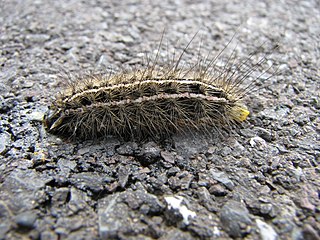
Apantesis is a genus of tiger moths in the family Erebidae first described by Francis Walker in 1855. They are found in North and Central America.

Apantesis quenseli, the Labrador tiger moth, is a moth of the family Erebidae. In Central Europe the species is found in the Central Alps at altitudes of 2,000–2,700 metres (6,600–8,900 ft). They are also present in Northern Scandinavia. It is widely distributed in Polar Eurasia, mountains of Siberia, Mongolia, North China, Japan, Polar North America.

Apantesis arge, the arge moth or arge tiger moth, is a moth of the family Erebidae. The species was first described by Dru Drury in 1773. It is found in North America from Quebec and Maine to Florida, West to New Mexico, North to North Dakota and Ontario.

Apantesis virgo, the virgin tiger moth, is a moth of the family Erebidae. The species was first described by Carl Linnaeus in his 1758 10th edition of Systema Naturae. It is found in North America from Newfoundland south to Florida west to Alberta.
Apantesis behrii is a moth of the family Erebidae. It was described by Stretch in 1872. It is found from Oregon south to California. It is most common in the Siskiyou and Sierra Nevada ranges. The habitat consists of dry lithosol flood plains and balds in the mountains.
Apantesis blakei, or Blake's tiger moth, is a moth of the family Erebidae. It was described by Augustus Radcliffe Grote in 1864. It is found on the North American Great Plains, and southern prairie provinces of Canada.
Apantesis complicata is a moth of the family Erebidae. It was described by Francis Walker in 1865. It is found on south-eastern Vancouver Island and several Gulf Islands of British Columbia and Washington. The habitat consists of dry Garry oak meadows and sandy beaches.
Apantesis doris, the Doris tiger moth, is a moth of the family Erebidae. It was described by Jean Baptiste Boisduval in 1869. It is found in North America from British Columbia, northern Idaho, Alberta and western Montana. In the east, it is found in the Atlantic Coast provinces and from Nova Scotia to northern Florida and west to central Texas. The habitat consists of open willow/sedge fens and probably other open wetlands in the boreal forest.
Apantesis eureka is a moth of the family Erebidae. It was described by Douglas C. Ferguson and B. Christian Schmidt in 2007. It has been found in the United States along the edges of the Great Basin in central Utah and in southwestern Idaho.

Apantesis figurata, the figured tiger moth, is a moth of the family Erebidae. It was described by Dru Drury in 1773. It is found in North America from southern Ontario and New Hampshire south to Georgia and west to Colorado and Texas.
Apantesis f-pallida is a moth of the family Erebidae. It was described by Strecker in 1878. It is found from south-eastern Utah and Colorado south to eastern Arizona, New Mexico and eastern Texas. It has also been recorded from west-central Nevada, and probably also occurs in Mexico.

Apantesis incorrupta is an arctiine moth in the family Erebidae, described by Henry Edwards in 1881. It is found from southern Colorado and south-eastern Kansas south through Arizona, New Mexico and western Texas into Mexico and west to south-eastern California. The habitat consists of grasslands and open woodlands.
Apantesis margo is a moth of the family Erebidae. It was described by Schmidt in 2009. It is found in grassland and transitional habitats on the northern Great Plains and Southern Rocky Mountain Front ranges, south to east-central Arizona.
Apantesis obliterata is a moth of the family Erebidae. It was described by Richard Harper Stretch in 1885. It is found in Russia, Mongolia and North America. The habitat consists of grasslands.

Apantesis ornata, the ornate tiger moth or achaia moth, is a moth of the family Erebidae. It was described by Alpheus Spring Packard in 1864. It is found in western North America from southern British Columbia through the Pacific Northwest to southern California, northern Utah, and western Wyoming and Montana. It is found in a wide range of habitats, including open woodland.
Apantesis philipiana is a moth of the family Erebidae. It was described by Douglas C. Ferguson in 1985. It is found in the far northwest of North America from Wrangel Island west to Mackenzie Delta in the Northwest Territories and south to Denali National Park in Alaska. It was named in honor of Kenelm Philip, a lepidopterist who started and ran the Alaska Lepidoptera Survey from 1970 to 2014.

Apantesis phyllira, the phyllira tiger moth, is a moth of the family Erebidae. It was described by Dru Drury in 1773. It is found in North America from Quebec and New England south to Florida and west to Texas, Colorado and Alberta. The habitat consists of dry, open woodland and grassland. The species is listed as endangered in Connecticut.
Apantesis placentia, the placentia tiger moth, is a moth of the family Erebidae. It was described by James Edward Smith in 1797. It is found in the south-eastern United States, from New Jersey to Florida. The habitat consists of dry, sandy open wooded areas, primarily pine barrens.
Apantesis speciosa is a moth of the family Erebidae. It was described by Heinrich Benno Möschler in 1864. It is found from Labrador west to British Columbia and Alaska. The habitat consists of wetlands, bogs and sub-Arctic tundra. The species is listed as endangered in Connecticut.

Apantesis virguncula, the little virgin tiger moth, is a moth of the family Erebidae.








